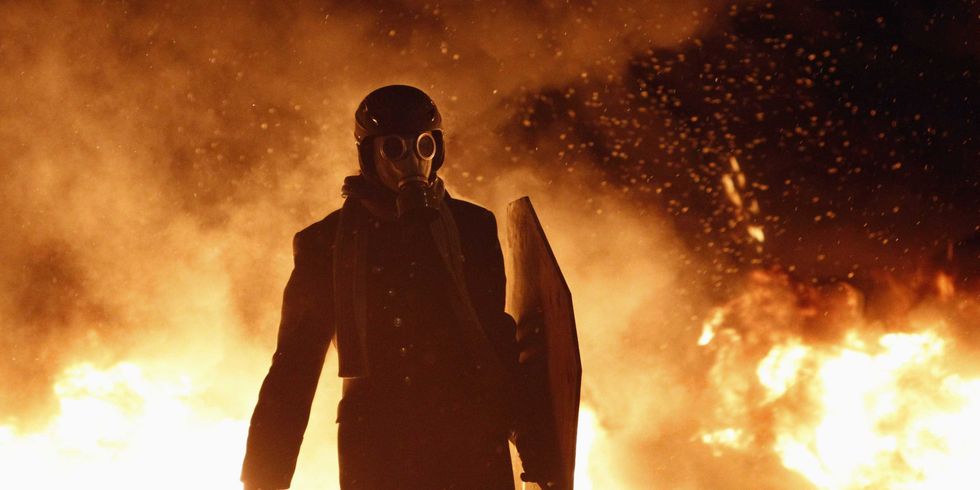In the last couple of months before I left Kyiv the protests were all that anyone talked about. Between classes people would chit chat about what had happened in Maidan the night before. What the Berkut (riot police) had done and how the protestors were responding. Mostly what the Berkut had done was beat the protestors with batons and metal shields and mostly the protesters had responded by getting hit with batons and metal shields.
There were some interesting exchanges, though. Back when people still expected the Berkut to provide an explanation for their violence, they’d offered the excuse that the protesters were preventing the orderly putting up of Christmas decorations. You see, that’s why we decided to block cellular service in the area and to throw canisters of tear gas into a crowd of unarmed civilians, it’s about getting into the Christmas spirit. The next day the protesters hung Christmas lights and ornaments around their tents and on the barricades.
Mostly I stayed out of these conversations, so I don’t want you to think that I’m an expert or anything. But living in Kyiv, there’s a certain amount that you can’t help but absorbing.
Now I live in America, and our riot police have their own way of getting into the Christmas spirit.
Like I said, I’m not an expert or anything. But following the Standing Rock protests, there are some similarities that I can’t help but noticing, and I think it’s important to talk about them, even if I’m not the most qualified person to do so. God knows nobody else is doing it.
There are plenty of surface similarities, the police brutality, the sort of rhetoric being thrown around, and the way the media downplays any violence on the part of the police while over reporting any violence coming from the protestors. These are things that I suppose are common to all protests.
The first time I began thinking that the similarities might go deeper than that was when I heard about the water cannons. Both Euromaidan and the Standing Rock protests took place during the winter, and in both cases those tasked with dispersing the protestors had the bright idea of spraying them with water.
The idea is pretty obvious: people who are in the process of freezing to death don’t tend to like standing in the snow for long periods of time.
There’s a difference in scale, though. I remember the winter of Euromaidan as being the coldest one I’ve ever experienced. The temperature rarely rose above -20, and sometimes the wind would whip the snow around so fast that you couldn’t see more than a couple of meters in front of your face. The Ukrainians that I knew said that the protestors were lucky for such a mild winter, normally it was much worse.
Standing rock is cold, but it’s not that cold. And if you ask me, that might actually be a problem for the protestors.
The time when the berkut began spraying protesters with water was right when they started entrenching themselves. That makes a lot of sense to me. If it’s -20 and you’re soaking wet, you’re going to die if you don’t get somewhere warm. So unless you want to go home and give up on this whole revolution schtick, you’re going to have to figure out a way to get warm and dry, right there in Independence Square, and once you’ve got that figured out you’re not a far cry away from setting up shelters and then organizing shifts for people to look out for police crackdowns during the night, and before you know it you’ve got a team of guys building a trebuchet just to see if they can.
In Standing Rock things are a little different. When people are hit with water cannons, it’s still not fun, but wet clothes don’t pose nearly the threat that they did at Maidan. Obviously that’s a good thing for protestors in the short term, but without the need to organize the protests might not have the staying power that they’ll need in order to accomplish real change.
The second time that I thought these protests might be more similar than people seem to think was when I heard about the drone ban.
We know what we know about the police brutality, in large parts because of videos like this one, shot from aerial drones. The response of the police has been to personally harass the drone pilots, and to do whatever they can to get the FAA to designate Standing Rock a no fly zone, so that this sort of journalism will be illegal.
I remember during Euromaidan, sitting in class and talking about the new anti-protest laws that the government had put in place. We were arguing about which of the new laws was the worst. There were plenty of candidates. One law granted amnesty to all members of the Berkut, just incase it wasn’t already clear whose side the government was on. Another expanded the legal definition of “extremist activity” to include churches that dared to house or feed protesters.
In the end, we decided that the most blatantly evil law was the anti-mask law. The law made any headgear that could potentially hide someone’s identity illegal. The stated logic was that if people were protesting, we should at least know who they are. Anyone who had faced a Berkut mob knew what this law really meant: we’re here to crack skulls, and from this point forward protecting yourself with a helmet is illegal.
Standing rock isn’t there yet, but the ethos of these anti drone laws is the same. Yes we’re doing things the American people would be angry if they saw, and from this point forward showing them is illegal.
I don’t put a lot of trust in governmental organizations or corporations, so my instinct is to say that these sorts of abuses are going to continue until we can find a way to hold those groups accountable. But honestly, with the way things are now, protests might be the best we’re going to get.






















